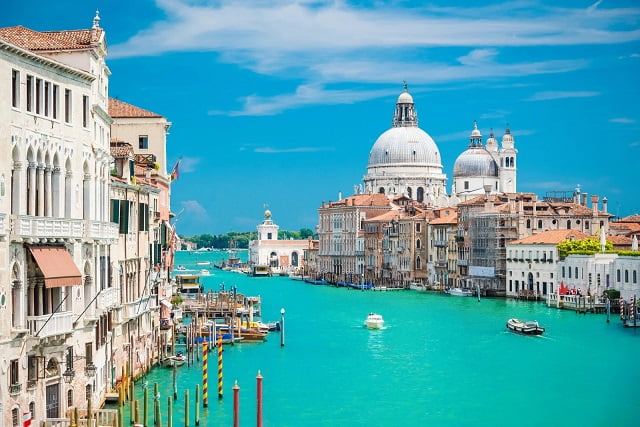Is Italy safe to travel to right now? This question is at the forefront of many travelers’ minds as they consider their future vacation plans. With the ongoing COVID-19 pandemic and fluctuating travel restrictions, it’s crucial to stay informed about the current situation in Italy and prioritize safety while traveling.
Italy, known for its rich history, stunning architecture, and delectable cuisine, has always been a popular destination for tourists. However, in light of the global health crisis, ensuring the safety of travelers has become a top priority for both visitors and local authorities. As we navigate these uncertain times, understanding the state of safety in Italy and adhering to necessary precautions are essential for a smooth and enjoyable travel experience.
In this article, we will delve into the current situation in Italy, including the latest COVID-19 updates, safety measures implemented by the government and local authorities, as well as specific guidance for tourist destinations, transportation, accommodation, and personal safety tips. Whether you’re considering a trip to Italy or simply staying informed about international travel conditions, this comprehensive guide aims to provide valuable insights and practical recommendations for traveling safely in Italy.
COVID-19 Updates
Italy has been significantly impacted by the COVID-19 pandemic, but the situation is gradually improving. As of the latest update, there have been declines in the number of new cases and deaths related to the virus. However, it is essential to stay informed about the current travel restrictions and requirements when considering a trip to Italy.
As of now, travelers should be aware of any entry requirements such as pre-travel testing or quarantine upon arrival. It is important to check for any travel advisories or warnings issued by official government sources or health organizations. These advisories may provide crucial information about specific regions with higher infection rates or areas where non-essential travel is discouraged.
The Centers for Disease Control and Prevention (CDC) and the World Health Organization (WHO) are valuable resources for up-to-date information on COVID-19 in Italy. Additionally, travelers should monitor updates from the Italian Ministry of Health and follow any guidelines or protocols they have established for visiting tourists.
Whether it’s essential travel question traveling safely post-pandemic has never been more critical. With proper precautions and awareness, it is possible to enjoy a safe and enjoyable trip to Italy.
Safety Measures in Italy
Italy has taken significant steps to ensure the safety of residents and visitors amid the ongoing COVID-19 pandemic. The Italian government, in collaboration with local authorities, has implemented various safety measures and guidelines to protect the public and prevent the spread of the virus. As a result, travelers may wonder, “is Italy safe to travel to right now?” Below are some key points regarding safety measures in Italy that address this concern.
Here are some important safety measures implemented by the Italian government and local authorities:
- Mask mandates: Face masks are required in indoor public spaces and on public transportation throughout Italy. This includes airports, train stations, buses, and taxis.
- Social distancing rules: People are encouraged to maintain a safe distance from others in public areas and while waiting in lines.
- Vaccination requirements: Some establishments may require proof of vaccination for entry, so it’s important for travelers to have their vaccination records readily available.
In addition to these general safety measures, different regions within Italy may have specific protocols in place to address local conditions and concerns. It is essential for travelers to stay informed about any updates or changes to the safety guidelines during their visit.
Overall, these safety measures demonstrate that Italy is taking proactive steps to prioritize the well-being of its residents and visitors. By adhering to these guidelines and staying updated on any new developments, travelers can help contribute to a safe and enjoyable experience while exploring all that Italy has to offer.
Tourist Destinations in Italy
Italy is known for its stunning tourist destinations, including the iconic cities of Rome, Florence, and Venice, as well as the beautiful Amalfi Coast and picturesque countryside. These destinations are not only rich in history, culture, and natural beauty but also boast a wide range of safety measures to ensure the well-being of visitors.
Safety Measures in Popular Tourist Destinations
As Italy gradually reopens to tourists amid the ongoing COVID-19 pandemic, popular tourist destinations have implemented various safety measures to protect both visitors and residents. Attractions such as the Colosseum in Rome, the Uffizi Gallery in Florence, and St. Mark’s Square in Venice have imposed capacity limits to ensure social distancing. Additionally, these attractions often require visitors to book tickets online in advance to manage crowd sizes effectively.
Specific Safety Protocols at Attractions
In addition to capacity limits and mandatory ticket reservations, many tourist attractions in Italy have implemented strict hygiene protocols. These may include temperature checks upon entry, hand sanitizing stations throughout the premises, and enhanced cleaning of high-touch surfaces. Some attractions have also adapted their exhibits or tours to allow for safe visitor flow and minimize contact between tourists.
Current Safety Status at Tourist Destinations
Overall, Italy’s popular tourist destinations are taking proactive measures to prioritize visitor safety while still providing an enjoyable travel experience. However, it is essential for travelers to stay updated on the latest safety guidelines and any specific restrictions at individual attractions before planning their visit.
As you consider a trip that includes visits to these renowned sites during these times it is important for you ask yourself is italy safe to travel right now? It is important that you consider all current regulations and non-pharmaceutical interventions mandated by health authorities before making any travel arrangements within Italy’s borders.
Transportation Safety
Italy is one of the most popular tourist destinations in the world, known for its rich history, stunning architecture, and delectable cuisine. However, travelers may be wondering, “Is Italy safe to travel to right now?” In this section, we will address the safety of transportation within Italy and provide tips for safe travel.
As of the current situation in Italy, the country has implemented various safety measures to mitigate the spread of COVID-19. It is important for travelers to stay updated on the latest information regarding COVID-19 cases and travel restrictions in Italy. While some areas may have specific advisories or warnings issued by official government sources, it is essential to comply with these guidelines for a safe travel experience.
When it comes to transportation safety in Italy, public transportation such as trains, buses, and taxis are generally considered safe options for getting around. However, it is crucial for travelers to adhere to any safety protocols set forth by transportation authorities. This includes wearing masks while using public transit, maintaining social distancing whenever possible, and following any specific guidelines provided by transport operators.
For those planning to use public transportation in Italy, it is advisable to research the specific regulations and guidelines implemented by each mode of transport. Additionally, travelers should exercise caution when boarding crowded vehicles and practice good hygiene habits throughout their journey. Choosing reputable taxi services or rideshare options can also contribute to a safer travel experience within Italy.
Overall, while traveling through Italy may present new challenges due to the ongoing pandemic, taking necessary precautions can help ensure a safe and enjoyable experience. Whether exploring bustling cities or serene countryside landscapes, travelers can navigate Italy’s transportation options while prioritizing their safety and well-being.
Accommodation Safety
When considering travel to Italy, the safety of accommodations is a key concern for many travelers. Fortunately, the Italian government has implemented stringent guidelines and safety measures to ensure the well-being of guests and staff at hotels, vacation rentals, and other lodging options.
Guidelines and Safety Measures
Hotels and accommodations in Italy have implemented strict cleaning and sanitization protocols to ensure the safety of their guests. Common areas, such as lobbies, elevators, and dining areas, are regularly disinfected, and hand sanitizing stations are readily available throughout the facilities. Additionally, staff members are required to wear masks at all times and undergo regular health screenings.
Many accommodations have also modified their check-in procedures to minimize contact between guests and staff. Online check-in options, contactless payments, and keyless entry systems are being increasingly utilized to provide a safer and more seamless experience for travelers.
Choosing Safe Lodging Options
When planning your stay in Italy, it is essential to choose reputable lodging options that prioritize safety. Look for accommodations that have received certification or recognition for their adherence to health and safety standards. Reading recent guest reviews can also provide insights into how well a particular establishment is managing safety protocols.
For those considering vacation rentals or Airbnb properties, communication with hosts regarding their cleaning practices and COVID-19 protocols is crucial. Inquire about their sanitation procedures between guests and any specific measures they have put in place to ensure a safe environment for visitors.
Overall, while there is always some level of risk involved when traveling during a global pandemic, with careful research and adherence to recommended guidelines, it
Personal Safety Tips
Italy has always been a popular tourist destination, known for its rich history, stunning architecture, and delicious cuisine. However, with the ongoing COVID-19 pandemic, many travelers are concerned about safety when visiting Italy. So, is Italy safe to travel to right now?
When it comes to personal safety in Italy during the current pandemic, there are several important tips to keep in mind. Firstly, it’s crucial to stay updated on the latest travel advisories and regulations issued by official government sources and health organizations. These will provide valuable information on any restrictions or requirements for travelers entering the country.
Additionally, practicing good hygiene is essential for staying safe while traveling in Italy. This includes regular hand washing with soap and water or using hand sanitizer when soap is not available. It is also advisable to carry a supply of face masks and wear them in crowded or enclosed spaces as per local guidelines.
Another key aspect of personal safety in Italy is remaining vigilant and aware of your surroundings. While exploring popular tourist areas, be mindful of your belongings and watch out for common scams targeting tourists. By staying informed and taking necessary precautions, travelers can help ensure their personal safety while experiencing all that Italy has to offer.
| Travel Tip | Description |
|---|---|
| Stay Informed | Keep up-to-date with travel advisories and regulations from official sources. |
| Practice Good Hygiene | Regularly wash hands with soap or use hand sanitizer, wear face masks as required. |
| Stay Vigilant | Be aware of surroundings, watch out for common tourist scams. |
Conclusion
For those wondering, is Italy safe to travel to right now amidst the ongoing COVID-19 pandemic, the answer depends on several factors. As of the latest update, Italy has implemented various safety measures and guidelines to ensure the well-being of both residents and visitors. The government and local authorities have introduced mask mandates, social distancing rules, and other protocols to control the spread of the virus.
In terms of tourist destinations in Italy, popular sites such as Rome, Florence, Venice, and the Amalfi Coast have also implemented safety measures to protect visitors. Some attractions may have limited capacity or require advance reservations to ensure proper distancing among guests. It is important for travelers to stay updated on specific requirements for each destination they plan to visit.
When it comes to transportation safety in Italy, public transportation such as trains, buses, and taxis have also adopted safety protocols. Travelers are advised to follow guidelines set by transport authorities and maintain proper hygiene practices during their journey.
As for accommodations in Italy, hotels and vacation rentals have prioritized cleanliness and implemented additional measures for guest safety. When choosing a place to stay, it is recommended to opt for reputable lodging options with clear guidelines on hygiene and sanitation.
Ultimately, while traveling to Italy right now comes with certain considerations and precautions due to the ongoing global health crisis, it is possible to have a safe experience by following established safety guidelines and staying informed about any developments related to travel.
Q&A Section
In conclusion, traveling to Italy right now is a decision that should be carefully considered in light of the ongoing COVID-19 pandemic. While the situation in Italy has improved significantly in recent months, it is important for travelers to stay informed about the latest updates and travel advisories. The Italian government has implemented various safety measures and guidelines to protect both residents and visitors, including mask mandates, social distancing rules, and restrictions on group gatherings.
As of the latest update, Italy has seen a decrease in COVID-19 cases and has been gradually easing travel restrictions. However, travelers should continue to monitor the situation and be prepared for any changes that may arise. It is also advisable to check for any specific requirements or regulations in place at tourist destinations and accommodations. When using public transportation, such as trains, buses, or taxis, taking necessary precautions and following safety guidelines is essential.
Ultimately, the decision to travel to Italy at this time depends on individual circumstances and risk tolerance. Despite the challenges posed by the pandemic, with careful planning and adherence to safety measures, it is possible to have a safe and enjoyable experience while exploring all that Italy has to offer. Remember to stay informed, take necessary precautions, and prioritize your health and well-being during your travels.
Frequently Asked Questions
Is Italy Safe for American Tourists Right Now?
Italy is generally safe for American tourists right now, but it’s essential to stay informed about any travel advisories and safety precautions. Always be aware of your surroundings and follow any local guidelines.
How Safe Is It to Fly to Italy?
The safety of flying to Italy depends on various factors such as the current COVID-19 situation, airline protocols, and personal health. It’s crucial to check the latest travel advisories and guidelines before making any decisions.
Are There Still Travel Restrictions to Italy?
As of now, there are still travel restrictions to Italy, including requirements for testing and quarantine upon arrival. It’s important to stay updated with the latest regulations and entry requirements before planning a trip to Italy.

I’m a passionate traveler, writer, and Italophile. My fascination with Italy’s history, art, and culture has led me on countless adventures across the Italian landscape. Through “I Live Italy,” I share my love for this extraordinary country and aims to inspire others to explore its boundless beauty.




